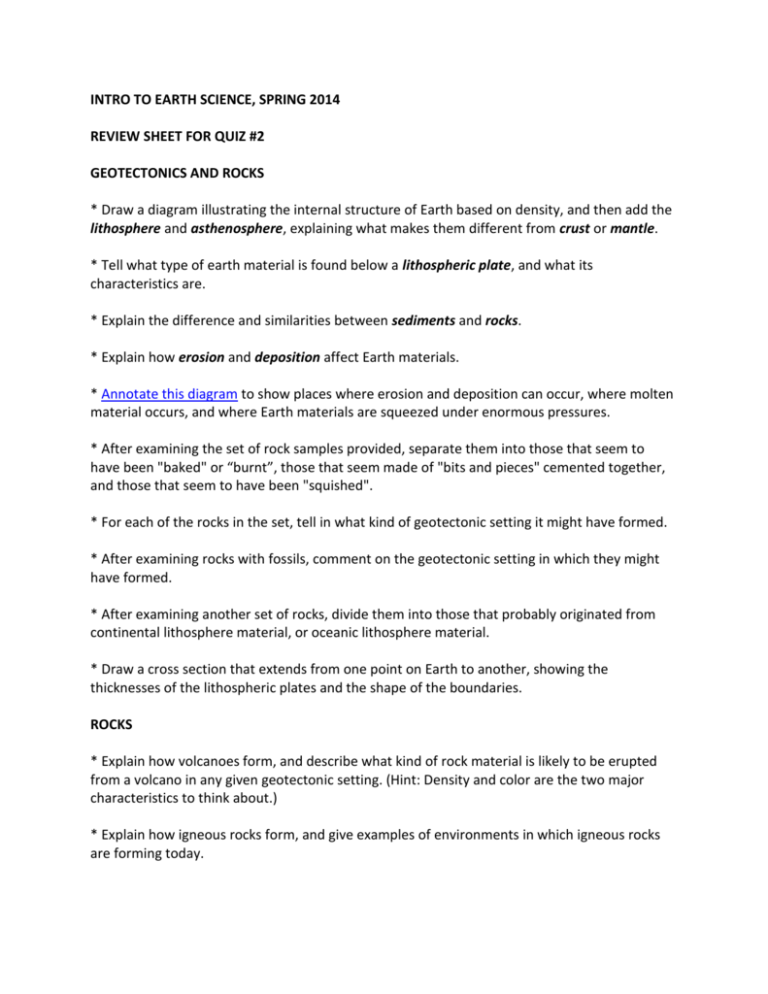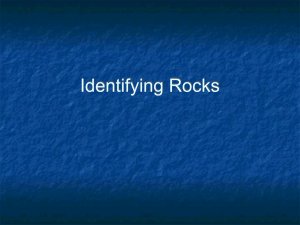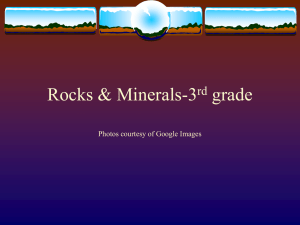Get the review sheet here!
advertisement

INTRO TO EARTH SCIENCE, SPRING 2014 REVIEW SHEET FOR QUIZ #2 GEOTECTONICS AND ROCKS * Draw a diagram illustrating the internal structure of Earth based on density, and then add the lithosphere and asthenosphere, explaining what makes them different from crust or mantle. * Tell what type of earth material is found below a lithospheric plate, and what its characteristics are. * Explain the difference and similarities between sediments and rocks. * Explain how erosion and deposition affect Earth materials. * Annotate this diagram to show places where erosion and deposition can occur, where molten material occurs, and where Earth materials are squeezed under enormous pressures. * After examining the set of rock samples provided, separate them into those that seem to have been "baked" or “burnt”, those that seem made of "bits and pieces" cemented together, and those that seem to have been "squished". * For each of the rocks in the set, tell in what kind of geotectonic setting it might have formed. * After examining rocks with fossils, comment on the geotectonic setting in which they might have formed. * After examining another set of rocks, divide them into those that probably originated from continental lithosphere material, or oceanic lithosphere material. * Draw a cross section that extends from one point on Earth to another, showing the thicknesses of the lithospheric plates and the shape of the boundaries. ROCKS * Explain how volcanoes form, and describe what kind of rock material is likely to be erupted from a volcano in any given geotectonic setting. (Hint: Density and color are the two major characteristics to think about.) * Explain how igneous rocks form, and give examples of environments in which igneous rocks are forming today. * Explain what the terms felsic and mafic mean. * Describe the type of volcanic eruptions characteristic of felsic magma and of mafic magma. * Explain the difference and similarities between sediments and rocks. * Explain how metamorphic rocks form, and give examples of environments in which metamorphic rocks are forming today. * Using your GeoTouring data, categorize your list of rocks and sediments according to whether the materials are igneous rocks, sediments, sedimentary rocks, or metamorphic rocks. Then, further categorize them into sub-groups. IGNEOUS ROCKS * How do they form? * How are they classified into groups? * List three names of igneous rocks and describe what group each one falls into and how you can tell. METAMORPHIC ROCKS * How do they form? * How are they classified into groups? * List three names of metamorphic rocks and describe what group each one falls into and how you can tell. CLASTIC (DETRITAL) SEDIMENTARY ROCKS * How do they form, and in what kinds of environments? * How are they classified into specific rock types? * List three names of clastic sedimentary rocks and describe what group each one falls into and how you can tell. CHEMICAL SEDIMENTARY ROCKS * How do they form, and in what kinds of environments? * How are they classified into specific rock types? * List three names of chemical sedimentary rocks, describe what group each one falls into, and how you can tell. SEDIMENTS * How are sediments made, transported, and deposited? *What processes are involved, and what important terms should we know? LITHIFICATION * How are sediments lithified (turned to solid rock)? * What substances make good cements? * Under what conditions will sediments lithify? ROCK DESCRIPTION AND IDENTIFICATION * Using hand samples, apply the principles taught in Tuesday's presentations to help you identify specific rock names. * Using the attached flow chart and your observations and descriptions of rock samples, assign names to hand samples of rocks.








